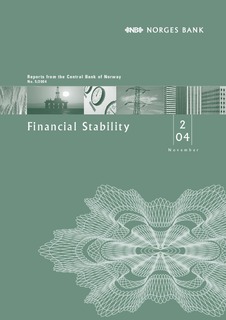Financial Stability 2/04
Report
Published version

Permanent lenke
http://hdl.handle.net/11250/2563495Utgivelsesdato
2004Metadata
Vis full innførselSamlinger
Beskrivelse
Financial stability means that the financial system is robust to disturbances in the economy and is able to mediate financing, carry out payments and redistribute risk in a satisfactory manner. Experience shows that the foundation for financial instability is laid during periods of strong growth in debt and asset prices. Banks play a central part in extending credit and mediating payments and are therefore important to financial stability. Pursuant to the Norges Bank Act and the Payment Systems Act, Norges Bank shall contribute to a robust and efficient financial system. Norges Bank therefore monitors financial institutions, securities markets and payments systems in order to detect any trends that may weaken the stability of the financial system. Should a situation arise in which financial stability is threatened, Norges Bank and other authorities will, if necessary, implement measures to strengthen the financial system. The report Financial Stability discusses the risks facing the financial system, particularly credit, liquidity and market risk. We use the designations low, relatively low, moderate, relatively high and high risk in a qualitative assessment of the degree of risk. Changes in the risk situation since the previous report are also evaluated. The risk assessment may be different for the short and for the long term. The report is published twice a year. The main conclusions of the report are summarised in a submission to the Ministry of Finance. The submission is discussed at a meeting of Norges Bank’s Executive Board. Norges Bank’s annual Report on Payment Systems provides a broader overview of developments in the Norwegian payment system.
Utgiver
Norges BankSerie
Financial Stability Report;2/2004Reports from the Central Bank of Norway;No. 5/2004
